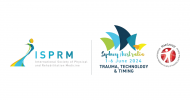Session outline
Progressive chronic lung disease (CLD) is very common and ubiquitous across the globe. Nearly 545 million individuals currently live with a CLD, representing 7·4% of the world’s population, and significantly contributing to functional limitation, premature morbidity and mortality. Rehabilitation interventions and pulmonary rehabilitation has been well documented to improve functional limitations related to CLD. The most common causes of CLD include chronic obstructive pulmonary disorders, cystic fibrosis, pulmonary hypertension and pulmonary fibrotic conditions. Whilst medical therapies are helpful in ameliorating symptoms and rehabilitation therapies enhance function and maintain quality of life in advancing CLDz, life expectancy is not significantly enhanced by these interventions.
Appropriately-timed lung transplantation, however, in combination with medical therapies and rehabilitation interventions significantly improves medical status, function, quality of life and life expectancy with an improved median survival of over 6 years. At this time annually, over 4 600 lung transplantations are performed worldwide of which 55% are performed in North America, 36% in Europe and 8% combined in Asia, Australia, South America and Africa. There are many patients waiting for lung transplantation yet the rate of lung transplantation only minimally increased from 3927 lung transplants in 2010 due to limited organ supply. In the USA in 2022 there were over 3,000 candidates added to the lung transplant waitlist with over 2,600 lung transplants performed. The average person waits around two years for a single lung transplant, and as long as three years for two lungs. Of concern, waitlist mortality increased from 14.7 deaths per 100 waitlist years in 2019 to 16.1 in 2020. Lung transplant candidates on waitlists typically deteriorate medically, progressively weaken due to limited activity and medication (steroid) side effects, and decline functionally and in quality of life.
There is tremendous potential for amelioration of this decline through rehabilitation strategies. This presentation will address the role and opportunity for physical medicine and rehabilitation practitioners in pre-, peri- and post- lung transplant rehabilitation for CLD. We will highlight how patients with CLD can benefit from a comprehensive pulmonary rehabilitation program to optimize health, function and improve suitability for lung transplant listing. The ‘stronger’ a patient is when approaching lung transplant, the better the outcomes post- lung transplant.
We will discuss how the rehabilitation team plays a critical role in early inpatient post-transplant rehabilitation and recovery and the value of ICU early mobilization programs. We will describe post-transplant inpatient and outpatient pulmonary rehabilitation emphasizing the essential knowledge rehabilitation professionals need to optimize medical and functional outcomes. We will frame the business model highlighting the value to hospitals, health systems and healthcare overall and the opportunity of involvement of physical medicine and rehabilitation teams from a fiscal, value based care perspective as well as a clinical outcome perspective. We will conclude by highlighting the potential functional heights lung transplant recipients can achieve in discussing metabolic fitness data in a group who successfully progressed to mountain climbing so providing hope and lofty goals for patients traversing the lung transplant journey.
Learning outcomes
Attendees on completing this scientific session should be able to:
- Discuss the impact of chronic lung disease on patients health, function and quality of life, and on healthcare resources
- Understand the positive impact of physical medicine and rehabilitation / pulmonary rehabilitation interventions for patients pre- and post-lung transplant on patient health and function and on value based care principles
- Outline the continuum of the rehabilitation course for patients with chronic lung disease before, during and after lung transplantation
- Describe the physiologic changes underlying the medical, physical and functional gains noted in post-lung transplant rehabilitation
- Appreciate the potential functional levels patients undergoing lung transplant rehabilitation can achieve to help motivate and goal-set for patients preparing for lung transplant
Target audience
The target audience for this workshop / who will benefit from attending:
- Allied health
- Medical practitioners
- Students
- Trainees
- Nursing staff


